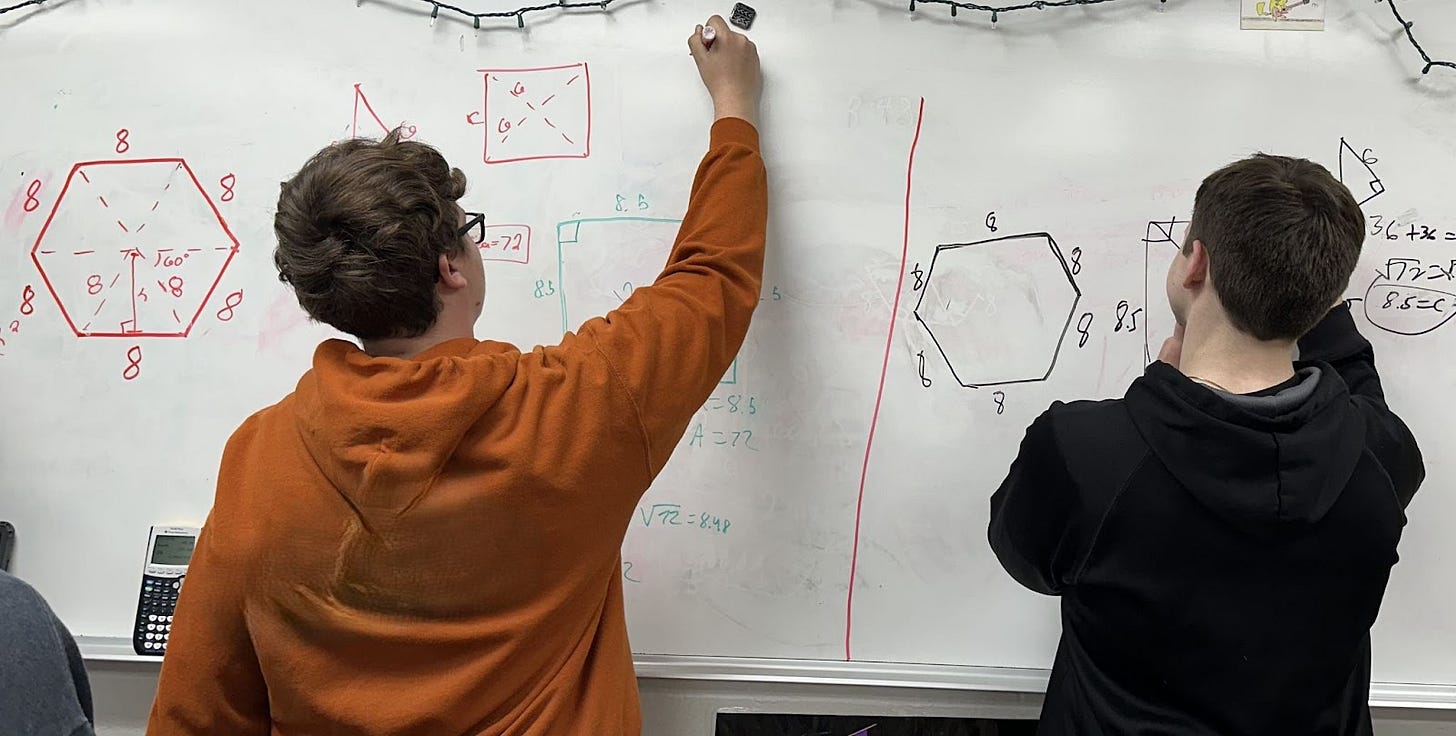This is my second year implementing ideas outlined in Building Thinking Classrooms in Mathematics by Peter Liljedahl. Overall, my students are doing a great job working on vertical non-permanent surfaces answering thinking questions. But this was not always the case.
For most of the year, one of my classes had been very adamant that they did not want to work on the white boards. I, however, am very adamant that they will work on the whiteboards. So they grudgingly go to the boards and work. Once groups start talking to each other, they do a great job answering the problems, and I had hoped that as we continued this routine, students would realize that they were becoming good problem solvers. Unfortunately, they did not come to this realization, and the complaining increased.
Do we have to work on the boards again?😒
By the end of November, all of my other classes were asking to work on the boards. Most students liked working with different random groups and preferred working on the boards over working at their desks. I couldn’t figure out why one class was still so opposed to working on the whiteboards.
One day the complaining had increased to the point where I was feeling defeated. I almost decided to let students work at their desks just to stop the complaining, but I am so glad I didn’t. Instead, I introduced the lesson and sent the students to the boards as usual. As students worked, I noticed that most groups were struggling except for the one group who had found the answer. So I had all students stop working, grab their note packets, and gather around to take notes as they listened to the group who had figured it out explain their work.
The next day I noticed that there was less complaining, and I wondered what had changed. I wondered if by showcasing the work of one group, I had filled a need for some of my students.
I wanted to try highlighting the work of specific groups more often but stopping class to examine student work can be time-consuming and can disrupt the flow of the class. Therefore, I decided to start taking pictures of the work on the boards with my phone. I would then display a picture and point out something interesting about each group's work the following day in class.
My students loved this recognition. I could feel the class dynamic changing. The complaining stopped, and the smiling started.
Can we work on the boards today? 🙂
Now my goal is to take pictures of student work and make a Google presentation for each lesson. I have the Google Slides app on my phone, which makes it very easy to copy pictures and add them to slides. Once the pictures are in a presentation, I can quickly edit and adjust the order of the slides on my computer. 7.2.2 Student Work
Having a presentation of student work allows me to do a better job consolidating a lesson. We often run out of time when I try to consolidate at the end of class. However, I find that creating a presentation using pictures of student work helps me to have a more focused class discussion about what the students learned from the lesson the day before.
Using presentations showcasing student work makes it easy to attend to three of the 5 Practices for Orchestrating Productive Mathematics Discussions by NCTM:
Selecting approaches and students to share them
Sequencing students’ presentations purposefully
Connecting students’ approaches and the underlying mathematics
I select the work I want to highlight by taking pictures as students work. I can sequence the work in the presentation to build a mathematical idea. Through our class discussion, the students make connections between their work and mathematical concepts.
Even if I don't get a chance to make a presentation, I have found that it is still beneficial to take pictures. I learn a lot about my students’ thinking when I look back at the pictures. I noticed ideas and strategies that I didn’t catch while I was busy running the lesson. The big advantage to having students work on white boards is that they engage quickly because they can erase mistakes. The downside to non-permanence is that there is no record of the work, and the act of erasing signifies unimportance. Taking pictures is a way of making students’ work permanent and recognizing student work helps build the status of the students.
A phone is one of a student’s most important possessions. Taking and posting pictures is the way they communicate and distinguish when something is important to them. By getting out my phone and taking a picture of a group's work, I am communicating to them that their work is important to me. This recognition costs me nothing and has a high return! So I challenge you to get your phone ready and take pictures.
I would love to hear about what you have learned from you students this year! Please feel free to tell me what has worked for you in a comment. Thank you!!







Wonderful! One thing I wonder about is whether to credit which student created the work. Usually I try to ask if they want to be credited by name or not. Sometimes I think they like to be named and sometimes I think they prefer anonymity. Sometimes I think it's good for students to try to figure out -- was that mine? Whose was that? Sometimes I don't credit if I want to highlight a mistake, even if it's a beautiful mistake. But either way, I agree, I can tell students like having their work appreciated and documented.
This information is very helpful. Thank you for sharing.